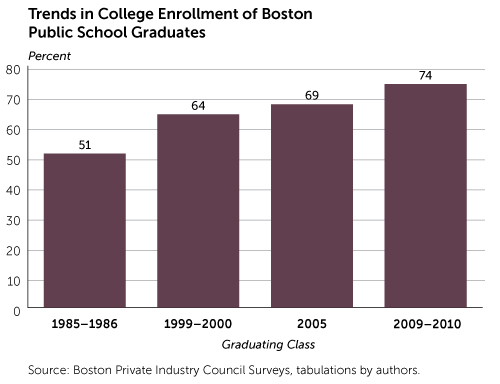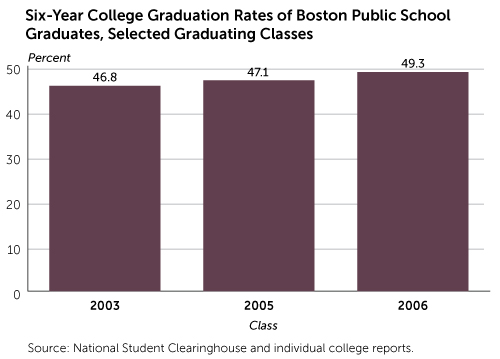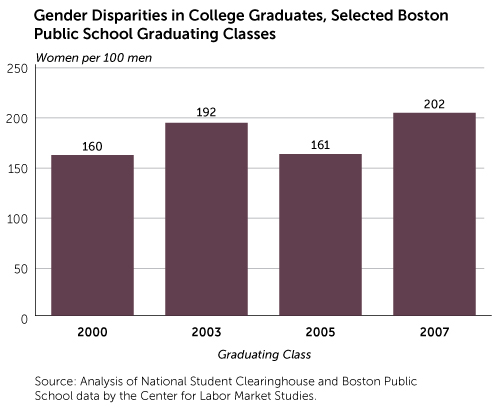The Success Boston Initiative 
The Success Boston Initiative is making headway in ensuring that Boston Public School graduates build on their improved college enrollment rates by bringing college graduation rates up, too.
Many political leaders have highlighted the importance of formal schooling to achieve both national and local goals. Boston's Mayor Thomas M. Menino, for one, has called upon public schools to improve both high school graduation rates and college graduation rates. He also has helped to establish the Success Boston Initiative, a coalition that includes the city, the Boston Public Schools (BPS), the Boston Foundation, and nearly 30 colleges and universities. The goal: to substantially boost college graduation rates of BPS graduates.
Benefits from College Completion
Graduation is what matters, not just enrollment. There are substantial economic benefits from achieving associate's and bachelor's degrees. For example, the mean lifetime earnings of Massachusetts adults from ages 22 to 64 rise considerably with educational attainment.
Mean Lifetime Earnings of Massachusetts 22-to-64-Year-Olds
|
Educational group |
Earnings |
| High school graduate, no postsecondary schooling |
$1,249,700
|
| Some postsecondary schooling but no degree |
$1,542,800
|
| Associate's degree |
$1,734,500
|
| Bachelor's degree |
$2,586,400
|
Source: American Community Surveys, 2007-2011. Tabulations by authors (in 2011 dollars).
Findings on mean lifetime earnings reveal that an adult obtaining a high school diploma but failing to complete any postsecondary schooling would be expected to earn about $1.250 million between ages 22 and 64. (See "Mean Lifetime Earnings." ) Those who completed some postsecondary schooling but received no degree would be expected to earn about $1.543 million, or nearly $300,000 more. Associate's degree holders have mean lifetime earnings of $1.735 million, while bachelor's degree holders have mean lifetime earnings of $2.586 million.
Such large differences in mean lifetime earnings between associate's degree holders and high school graduates (nearly $500,000) and between bachelor's holders and high school graduates ($1.337 million) also prevail among both men and women and among Asians, Blacks, Hispanics, and Whites.
The higher lifetime earnings yield greater lifetime tax payments to national, state, and local governments, and the individuals are less likely to need benefits from safety-net programs.

College Enrollment Trends
Knowledge of the college enrollment behavior of Boston Public School graduates in the first year following graduation from high school has been available since the mid-1980s. An annual follow-up survey sponsored by the Private Industry Council has been used to track their employment, college enrollment, and training-program enrollment status in the late winter- spring of the year following graduation from high school. In more recent years, data from the National Student Clearinghouse (NSC) has been used to track their college enrollment, persistence, and graduation outcomes.
The Private Industry Council survey data show that in the mid-1980s, only 51 percent of BPS graduates were enrolled in college in the first year following graduation from high school. By the end of the 1990s, the college enrollment rate had risen to 64 percent and had reached an average of 74 percent for the classes of 2009 and 2010, about 5 percentage points higher than for all U.S. high school graduates from the same two classes. (See "Trends in College Enrollment." )
National Student Clearinghouse data also show increases in first-year enrollment rates for BPS students graduating between 2005 and 2010 from 61 percent to nearly 70 percent. The Clearinghouse data track college enrollments over time rather than at only one point in time. For example, for the BPS Class of 2009, the NSC data reveal a 60 percent to 61 percent college enrollment rate in the fall following graduation from high school, rising to 67 percent for the late spring of 2010 and to nearly 76 percent three years after graduation from high school.
First-year college attendance rates have improved across the board for the three graduating classes from 2007 to 2009 and for both gender groups and each race and ethnic group. However, for Class of 2009 graduates, important differences in college enrollment rates remained across gender and race, with women outpacing men (71 percent vs. 63 percent), and Asians (83 percent) and Whites (77 percent) exceeding Blacks (64 percent) and Hispanics (59 percent).
Class of 2009 College Persistence Rates
Achieving the college graduation goals of Success Boston will require keeping students continuously enrolled in college through graduation. Over the past few years, a number of efforts have been implemented by community colleges nationwide to improve the academic preparation, classroom performance, course enrollment, college persistence, and graduation rates of their students. These demonstration efforts have included a variety of approaches, including innovative academic remediation, student learning communities, and incentive scholarships. Unfortunately, the results are mixed, with the most favorable outcomes involving increased short-term enrollment, summer enrollment, and more academic credits, with little effect on long-term persistence or graduation.
As part of the Success Boston initiative, an intervention involving the assignment of case managers and coaches to individual college students has been implemented by providers including the Boston Private Industry Council and community-service organizations. Center for Labor Market Studies (CLMS) researchers have been working with the Boston Foundation to assess outcomes and impacts. For the Class of 2009, CLMS matched Success Boston coaching participants at seven local colleges and universities with a comparison group of nonparticipants from the city's non-exam high schools attending the same colleges. The seven colleges and universities included two local community colleges and five different four-year colleges and universities, four of which were located in Boston.[1]
Success Boston vs. Comparison Groups' Persistence in College, Class of 2009
|
Group |
Enrolled in Sucess Boston |
Not in Sucess Boston |
Absolute difference (in percentage points) |
|||
|
One-year persistence |
Two-year persistence |
One-year persistence |
Two-year persistence |
One-year persistence |
Two-year persistence |
|
|
All |
86.4 |
73.4 |
66.0 |
49.9 |
+20.4 |
+23.5 |
|
Male |
83.3 |
66.7 |
62.5 |
46.6 |
+20.9 |
+20.1 |
|
Female |
88.1 |
77.1 |
70.0 |
53.6 |
+18.1 |
+23.5 |
|
Black |
90.3 |
77.4 |
64.8 |
49.6 |
+25.6 |
+27.8 |
|
Hispanic |
82.6 |
66.3 |
58.6 |
42.7 |
+24.0 |
+23.6 |
Source: Authors' calculations based on National Student Clearinghouse data.
The one-year college persistence rate of Success Boston participants exceeded that of the comparison group by 20 percentage points. (See "Success Boston vs. Comparison Groups." ) The regression-adjusted gap was nearly 17 percentage points. The gap in two-year persistence rates was 23 to 24 percentage points. Among both men and women, the unadjusted gap in two-year college persistence rates was more than 20 percentage points and was in the 23-to-28-percentage-point range for both Blacks and Hispanics. The preliminary unadjusted findings for year three are in the 21-percentage-point range.

College Graduation in Recent Years
A primary goal of the Success Boston Initiative is to increase the six-year college completion rate for BPS college enrollees to 52 percent for the Class of 2009 and to 70 percent for the Class of 2011. Over the past few years, the six-year college graduation rates of those BPS graduates enrolled in college in the first year following graduation have been modestly improving. (See "Six-Year College Graduation Rates." ) For the Class of 2006, the graduation rate increased to 49.3 percent, only three percentage points shy of the 52 percent goal set for the Class of 2009.
College graduation rates, however, varied widely across gender, race/ethnic, and academic achievement groups as well as by type of college attended. For the Class of 2006, college graduation rates varied from a low of 33 percent for Black men to highs of 77 percent for White and Asian women. For Class of 2005 BPS graduates, graduation rates as of late spring 2012 ranged from a low of 14 percent for those attending two-year public colleges to 66 percent for those attending four-year institutions.
Gender Disparities in College Degree Attainment
The gender disparity observed in college graduation rates is reflected even more markedly in the comparative number of college degrees received by male and female graduates from selected BPS graduating classes from 2000 to 2007. (See "Gender Disparities in College Graduates." ) For each of the four classes, the number of BPS female graduates with college degrees per 100 men ranged from 160 to a high of 202 for the Class of 2007. These ratios are considerably above both the state and national averages. In the 2011-2012 school year, the total number of degrees from associate's degrees to PhDs awarded to female graduates in the United States exceeded that of men by about 42 percent.

Of the nearly 800 college degrees received by Class of 2007 BPS graduates through the end of calendar year 2012, women earned more than twice as many degrees as men. The relative size of these gender gaps in college degree attainment varied widely across the four major race/ethnic groups. They ranged from a low of 116 for Asians to over 190 for White non-Hispanics to highs of 253 to 268 among Hispanics and Blacks. Such gender gaps reflect the outcomes of an array of behaviors, including higher rates of high school graduation among women than men, a higher rate of college enrollment among female high school graduates, and stronger college persistence rates among women. A better understanding of the educational, cultural, and social forces driving the gender gaps in degree attainment is needed. There are no current initiatives aimed at addressing gender imbalances.
Andrew Sum is a professor of economics at Northeastern University and director of the Center for Labor Market Studies. Ishwar Khatiwada is associate director and Sheila Palma is an administrative assistant and research associate at the center. Contact them at a.sum@neu.edu.
Endnotes
[1] The enrollees were recruited by the staff of local service providers. There was no random assignment of graduates to the treatment or control group. In 2011, CLMS staff worked with Boston Foundation staff to develop a comparison group of similar BPS graduates attending seven selected colleges. The matching was done by student MCAS score, gender, and race, and involved the use of regression analysis to estimate impacts.
[Back to story]
Articles may be reprinted if Communities & Banking and the author are credited and the following disclaimer is used: "The views expressed are not necessarily those of the Federal Reserve Bank of Boston or the Federal Reserve System. Information about organizations and upcoming events is strictly informational and not an endorsement."

 About the Authors
About the Authors
Andrew Sum, Center for Labor Market Studies
Ishwar Khatiwada, Center for Labor Market Studies
Sheila Palma, Center for Labor Market Studies



